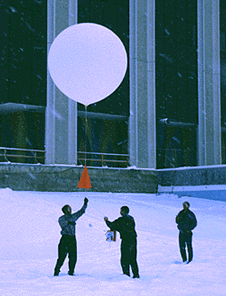Stratospheric OzoneOzone is made in the upper stratosphere, where there are the highest amounts of ultraviolet rays available for photolysis. Ozone production takes place near the equator; dissociation occurs at the poles. Moving the ozone from the area of production to the area of destruction is dependant on meteorology.
 Measurements of ozone in the stratosphere can be taken by balloon, satellites, or aircraft. The equipment can be like the TOMS (Total Ozone Mapping Spectrometer), or NASA's ER-2 aircraft, or even devices installed on commericial flyers. For example, the project NOXAR put equipment on SwissAir. The data found can be expressed in partial pressure (Pa), volume mixing ratios (ppm), density (molecules per cubic centimeter), or column depth. Column depth is measured in Dobson Units (DU). That is the integral of the ozone density over the height of the atmosphere. It is the physical depth that all the ozone would occupy if it were an ideal gas at STP. 1 DU is equal to 10(-3) atm-cm or 0.001 cm thickness at STP.
There is rarely more than ten ppm of ozone in the stratosphere or about 500 DU. The average amount of ozone is about 300 DU That means if the total amount of ozone surrounded the globe at the same thickness, the layer would be only three mm thick.
 Report technical/content problems here |